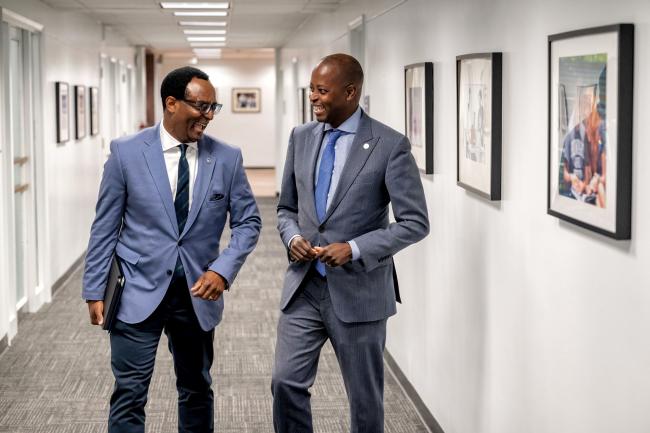Written By Howard University Newsroom Staff
Howard University released a retrospective assessment of the progress made toward aspirations set by the Howard Forward Strategic Plan. Launched in 2019 under the leadership of President Emeritus Wayne A. I. Frederick, M.D., MBA, Howard Forward has bolstered academic excellence, research capacity, and financial stability at the University.
Led by the Office of the Chief Strategy Officer, the Howard Forward Retrospective Assessment reflects a thorough review of the University’s plans of implementation and impact, involving a broad cross-section of the Howard community through online surveys, in-person workshops, and qualitative interviews with students, staff, and faculty. These findings highlight several key areas of success as well as opportunities for future growth at Howard.
Key Howard Forward achievements include Howard’s rise among top research institutions and HBCUs, a notable increase in scholarship funding and financial aid, and a surge in undergraduate applicants. The University has exceeded its research funding goals, becoming the first HBCU to partner with the Pentagon for a $90 million research contract, marking considerable progress in research and development.
Community service efforts include extensive healthcare services, support for Black entrepreneurship and affordable housing, alongside high participation in service programs. Operationally, Howard is investing $785 million in campus renovations and new academic centers. Financial milestones include a substantial increase in assets and endowment, significant donations, and positive credit ratings, underscoring Howard’s fiscal health and strategic success.
President Ben Vinson III, Ph.D., shared his reflections on the findings, highlighting the pivotal role of community input in guiding the University’s strategic path.
“The feedback we received from the community on how to center diverse perspectives at Howard throughout the strategic plan decision-making and execution process has been invaluable,” Vinson said. “Between this assessment and my Bison Engagement Tour, we now have a better understanding of the strengths of Howard Forward, and we are poised to commit to operational transformation, aggressively pursue innovation, and continue to strive for academic excellence in our next strategic plan.”
Comprehensive Findings outlined in the report include:
- Leadership and Renewed Focus: The transition to new leadership was overwhelmingly seen as a catalyst for positive change, energizing the University’s strategic direction and signaling a new era of focused advancements.
- Campus Mission and Identity: The core mission of Howard has been a significant motivator, with strategic efforts strengthening the University’s unique position as a leader in education and community engagement.
- Infrastructure Improvements: Investments in campus infrastructure have markedly enhanced the learning and living environments. However, there is a recognized need for ongoing developments to avoid viewing Howard Forward merely as a capital initiative.
- Effective Outreach and Engagement: The communications surrounding recent campus administrative initiatives reflect Howard’s commitment to effective engagement. Some of these efforts, which included videos, updates, and outreach, resonated with respondents as demonstrating potential tactics to consider for rallying support and participation.
- Desire for Tangible Outcomes: Stakeholders expressed a strong desire for more visible, real-world impacts of strategic initiatives to validate the plan’s relevance and success.
Key Themes from Community Feedback:
- Inclusiveness and Transparency: There is a call for more inclusive planning processes and transparent communication to ensure all voices are heard and integrated into the strategic direction.
- Balanced Development: Students highlighted the need to balance physical infrastructure developments with educational and community-focused objectives, ensuring that capital improvements support the broader strategic vision.
- Social Media and Communication: Enhancing social media engagement to better connect with students and the broader community was identified as a crucial area for improvement.
- Safety and Accessibility: Emphasizing campus safety and improving transportation links within the strategic plan were noted as essential for fostering a supportive and accessible University environment.
Building on this invaluable feedback, the next phase of Howard’s strategic planning will focus on refining and expanding the University’s impact through operational transformation, aggressive pursuit of innovation, and continued academic excellence. As the Vinson administration continues the charge alongside students, staff, faculty, and alumni toward the full potential of “Howard at maximum strength,” Vinson invites the entire Howard community to engage with these findings and participate actively in shaping Howard’s future.

